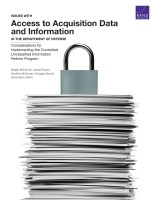| 来源类型 | Research Reports
|
| 规范类型 | 报告
|
| DOI | https://doi.org/10.7249/RR2221
|
| ISBN | 9780833099792
|
| 来源ID | RR-2221-OSD
|
| Issues with Access to Acquisition Data and Information in the Department of Defense: Considerations for Implementing the Controlled Unclassified Information Reform Program |
| Megan McKernan; Jessie Riposo; Geoffrey McGovern; Douglas Shontz; Badreddine Ahtchi
|
| 发表日期 | 2018
|
| 出版年 | 2018
|
| 页码 | 62
|
| 语种 | 英语
|
| 结论 |
- Implementation of the new Controlled Unclassified Information (CUI) program is destined to be disruptive.
- Given the emphasis on the importance and specificity of labeling information, training is likely to be extensive, including both Department of Defense (DoD) employees and contractors.
- Implementation is currently unfunded, and it is not clear how much of a financial burden implementation will be on those who need to implement.
- Several commonly used labels on acquisition information are no longer permitted, which will leave DoD employees and contractors looking for the next "FOUO."
|
| 摘要 |
- Identify a point-of-contact within the Office of the Under Secretary of Defense for Acquisition, Technology, and Logistics (OUSD[AT&L]) to help advise and transition to the new marking regime.
- Actively engage in discussions with the Undersecretary of Defense for Intelligence (USD[I]) during the revision of the DoD CUI policy.
- Work closely with the National Archives and Records Administration as needed to understand some of the current guidance that has been issued at the federal level.
- Hold small working groups with the military services and DoD functions (e.g., Comptroller, etc.) in order to further understand the implications of this effort.
- Begin to work to identify training resource requirements.
- Wait to implement until USD(I) completes the guidance per USD(I)'s strong recommendation.
- Carefully monitor changes to both the Controlled Unclassified Information (CUI) registry and any potential changes to the overall federal CUI strategy by the Trump administration.
- In regard to data aggregation, Deputy Director, Enterprise Information in OUSD(AT&L) should consider using the NIST's aggregation tool described in Chapter Three as a mechanism for systematically combing through the information systems that it currently manages for potential aggregation.
|
| 主题 | Databases and Data Collection
; Analysis
; and Processing
; Military Acquisition and Procurement
; Military Information Technology Systems
; United States Department of Defense
|
| URL | https://www.rand.org/pubs/research_reports/RR2221.html
|
| 来源智库 | RAND Corporation (United States)
|
| 引用统计 |
|
| 资源类型 | 智库出版物
|
| 条目标识符 | http://119.78.100.153/handle/2XGU8XDN/108716
|
推荐引用方式
GB/T 7714 |
Megan McKernan,Jessie Riposo,Geoffrey McGovern,et al. Issues with Access to Acquisition Data and Information in the Department of Defense: Considerations for Implementing the Controlled Unclassified Information Reform Program. 2018.
|
|
文件名:
|
x1516810302473.jpg
|
|
格式:
|
JPEG
|

|
文件名:
|
RAND_RR2221.pdf
|
|
格式:
|
Adobe PDF
|
除非特别说明,本系统中所有内容都受版权保护,并保留所有权利。